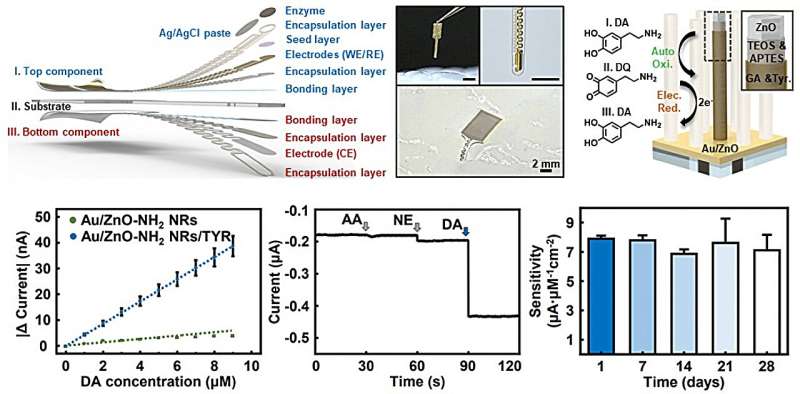This article has been reviewed according to Science X's editorial process and policies. Editors have highlighted the following attributes while ensuring the content's credibility:
fact-checked
peer-reviewed publication
proofread
Real-time dopamine measurement using a flexible probe that minimizes brain damage

A research team led by Jang Kyung-in, a Professor affiliated with the Department of Robotics and Mechatronics Engineering at DGIST, developed a dopamine measurement device that can precisely analyze dopamine concentration in real-time while minimizing brain damage.
Because the device facilitates accurate real-time dopamine measurements by using only one flexible brain-implantable probe, it is expected to be used as a core technology for developing customized probes for patients with degenerative brain diseases. The findings are published in the journal Advanced Functional Materials.
Dopamine is a crucial neurotransmitter that is widely distributed in the central nervous system and is associated with brain functions, such as motivation, memory, and reward. When dopamine concentration in the brain is abnormally high or low, it can cause degenerative brain diseases. For this reason, it is important to measure dopamine concentrations in the brains of patients suffering from these diseases.
Existing brain-implantable probes have a stiff structure that is inappropriate for soft brain tissue, and at least two probes are required for dopamine measurement. Because of these problems, existing brain-implantable probes may cause damage to, or inflammation in, brain tissue, disturbing the ability to consistently and accurately measure dopamine levels.
Researchers have proposed technologies for developing brain-implantable probes based on flexible devices; however, these technologies still require either large probes or the insertion of multiple probes, which can lead to significant brain damage.
To overcome the limitations of existing probes, Prof. Jang's research team developed a technology that facilitates dopamine measurement by safely and stably inserting only one flexible, long-term probe. The proposed probe has a double-sided structure, with working and reference electrodes installed on one side and a counter electrode installed on the other side. Based on this structure, the proposed probe provides a measurable area approximately twice as large as that of existing probes (based on a single surface structure) while maintaining the same insertion area.
In addition, the specific surface area of the proposed probe was significantly expanded through the implementation of a complex three-dimensional nanorod structure based on zinc oxide (ZnO) in the working electrode. Therefore, the proposed technology is regarded as a new probe-based dopamine sensor that minimizes damage to brain tissue and maximizes probe functions.
When electrodes are located on both sides of a probe, the distance between the probe's neutral layer and the electrodes increases. This structural limitation leads to a mechanically unstable condition of electrodes at the time of probe modification. To solve this problem, Prof. Jang's research team designed a serpentine-patterned microelectrode that can contribute to the mechanical stability of electrodes, despite their modification.
Prof. Jang states, "The developed probe based on the double-sided structure facilitates highly precise and stable long-term dopamine concentration measurement, which was not achieved by the use of existing probes. It has the potential to serve as a standard for probe development to support patients with brain diseases."
He added, "The precision and stability of the developed probe were verified through experiments on mice. We will conduct further research to introduce more enhanced brain-implantable probe technology that can increase the satisfaction of patients with brain diseases throughout their lives."
More information: Han Hee Jung et al, Highly Deformable Double‐Sided Neural Probe with All‐in‐One Electrode System for Real‐Time In Vivo Detection of Dopamine for Parkinson's Disease, Advanced Functional Materials (2023). DOI: 10.1002/adfm.202311436


















